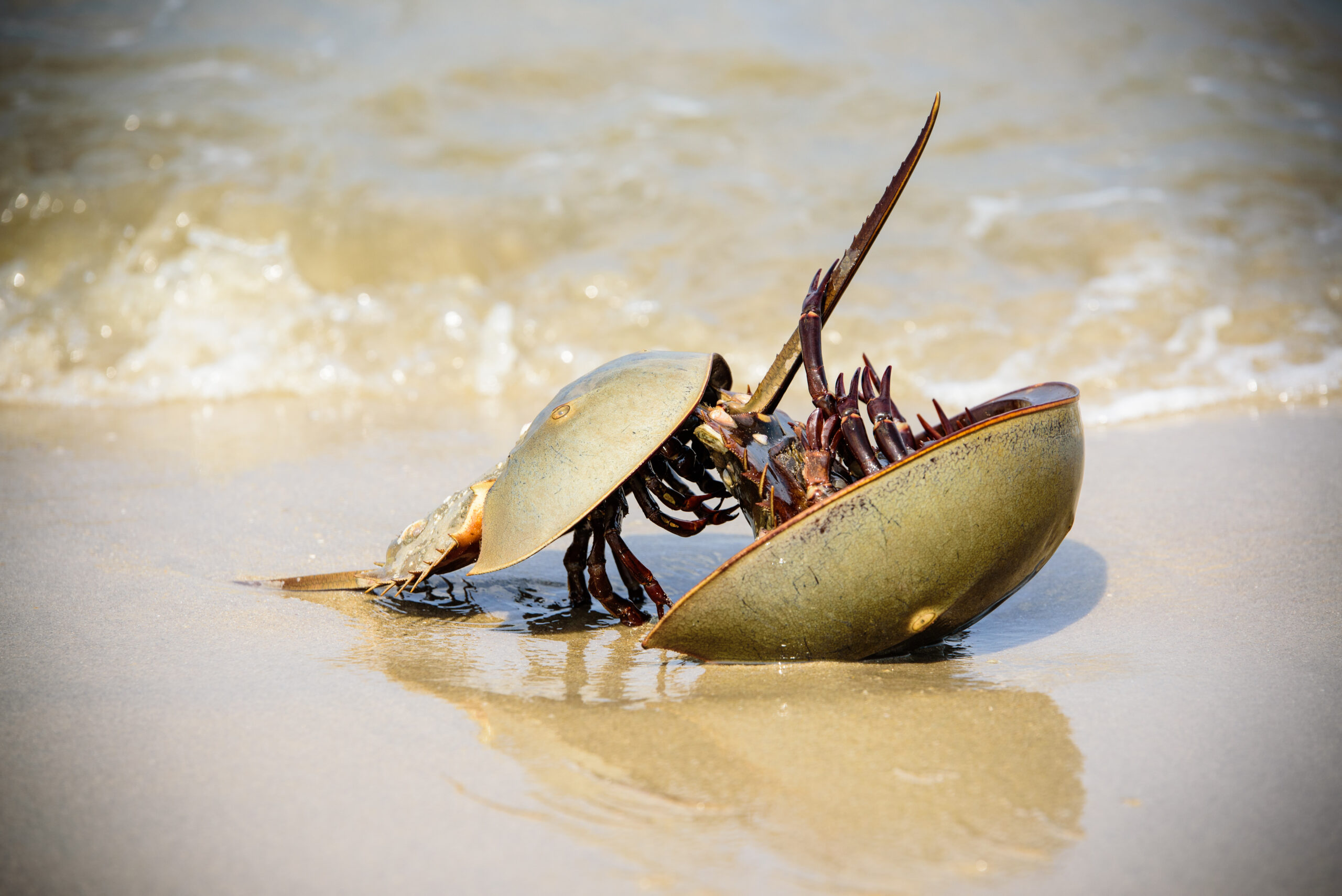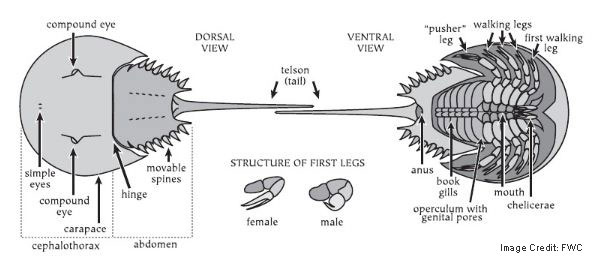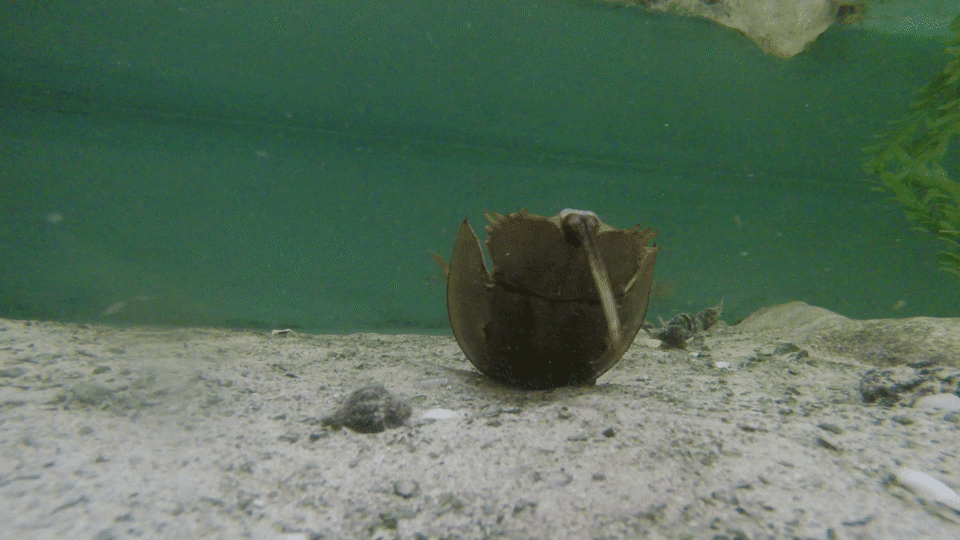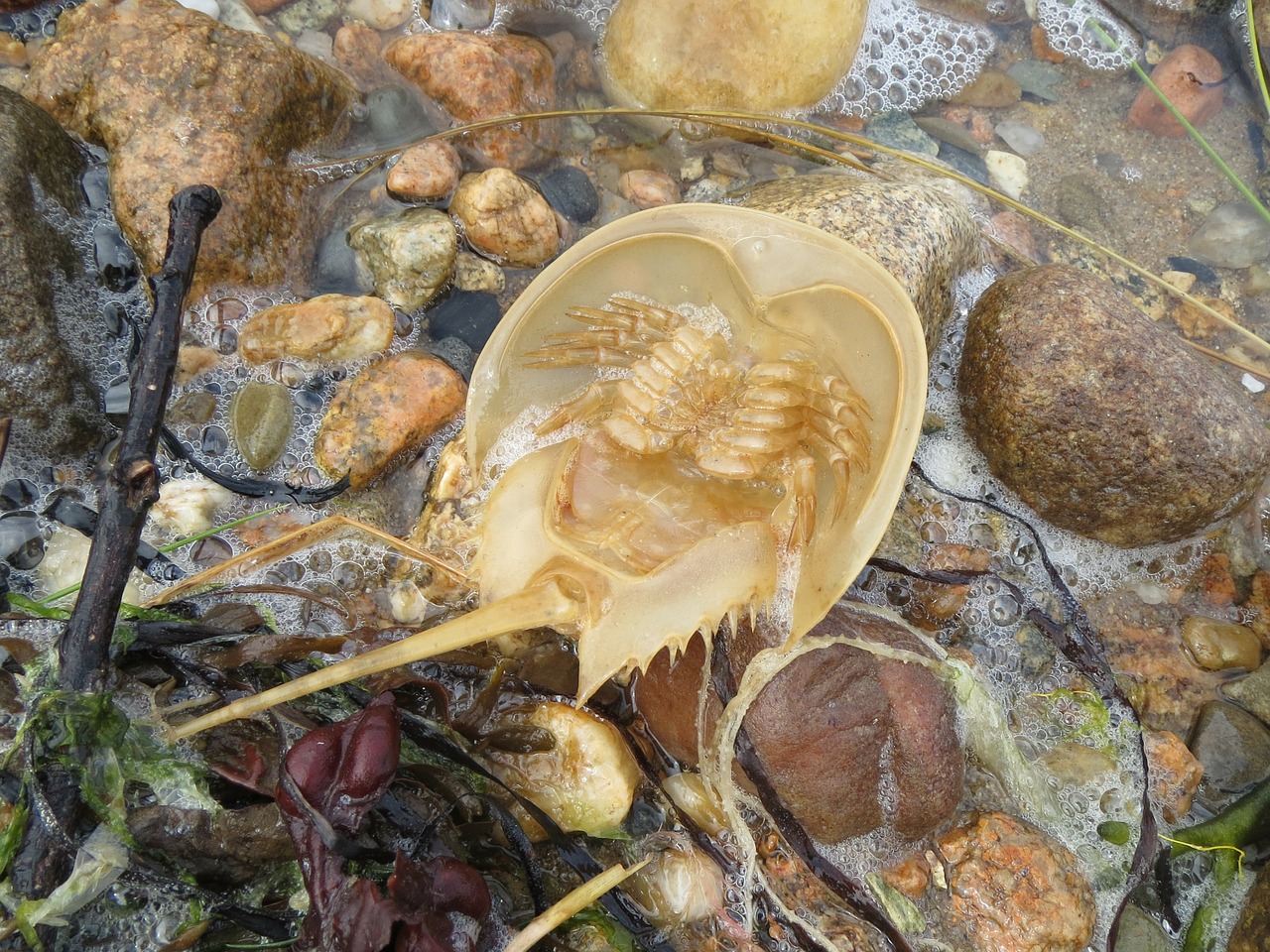11 Facts About Horseshoe Crabs That Will Blow Your Mind
Are these ancient tank-like looking little creatures even ... crabs?

If you’ve never encountered or learned about horseshoe crabs before, I have a treat for you. One of my absolute favorite marine species, these oddly charming marine arthropods get their name from their horseshoe-shaped exoskeleton, called a carapace. I’ve always thought that the exterior appearance of these animals was one of their most fascinating qualities, but it turns out there’s so much more to them than meets the eye. Read on to find out some of the most mind-blowing facts about one of our ocean’s most intriguing bottom-dwellers: the horseshoe crab.
Get Ocean Updates in Your Inbox
Sign up with your email and never miss an update.
They’re living fossils.
These ocean critters predate the dinosaurs! The oldest known horseshoe crab species, (Lunataspis aurora) was discovered by scientists in 2008 and is estimated to be nearly 450 million years old. While they’ve certainly experienced a few evolutionary adaptations, their physiology has remained largely unchanged over time, which is why they’re so often referred to as ‘living fossils.’ Four species are known to be alive today, and only one calls American waters home: the Atlantic horseshoe crab (Limulus polyphemus). This species can be found from Maine all the way to Mexico, typically populating deeper waters as adults but traveling to shorelines each year to spawn.

No, they’re not actually crabs.
Horseshoe crabs are much more closely related to arachnids like spiders and ticks than true crabs. They’re part of the Subphylum Chelicerata and are further classified into Class Merostomata, which includes horseshoe crab species as well as eurypterids (sea scorpions). Interestingly, the term Merostomata translates to “legs attached to the mouth.” Speaking of which…
They’ve got legs near their mouth.
While their primary sets of legs are used to help them move around, the pair of legs that’s closest to their mouth is actually a set of pincers, which they use to move food closer to their mouth and crush it up to be easier to consume. If you were wondering, some of their favorite foods are sea worms, mollusks and crustaceans. Adults tend to opt for bivalves once they’ve matured in size, but youngsters tend to like to go for the easy-to-maneuver marine worms.

They’re not dangerous.
While many people mistakenly associate these animals with rays or skates because of their shape, they’re actually not related and aren’t dangerous at all. Their tails, called telsons, aren’t poisonous or venomous; they’re mainly used to steer and flip themselves over in case they get stuck on their backs.

They can swim upside-down.
Flap-like structures near their abdomen, called book gills, enable horseshoe crabs to breathe underwater … but sometimes, they use them for the goofier purpose of swimming upside-down. It’s mainly the youngsters that engage in this behavior, but it’s entertaining to watch nonetheless.
Spawning season is an absolute spectacle.
Every spring when the tide is high, horseshoe crabs travel up to the shoreline to mate and lay their eggs at night. One of the most famous locations of these “love fests” occurs in Delaware Bay every year, where hundreds of thousands of these ancient critters can be seen on the shore. When it’s time to lay her eggs, a female horseshoe crab will deposit somewhere around 4,000 eggs in clusters. She’ll do this several times, laying up to around 20,000 eggs in one night and up to some 100,000 in each meeting season. That’s a lot of horseshoe crab babies!
Their eggs are a main food source for many coastal species.
While the number of eggs a horseshoe crab mom lays is jaw-dropping, most of the eggs will not survive to adulthood, or even to their hatching point. Scientists calculate that a very small percentage make it to maturity because the eggs serve as an important source of food for wildlife like migratory birds, sea turtles and some fish species. While Atlantic horseshoe crab populations are currently listed as vulnerable by the IUCN (International Union for the Conservation of Union)’s Red List of Endangered Species, this listing is primarily a result of anthropogenic (human-caused) sources and habitat loss, and not as much a result of natural predation by other traditional species.
They can see ridiculously well.
With 9 eyes in total along with various light receptors near their telson, these creatures have insanely good vision. They have different core purposes, too; their two lateral compound eyes are often used to help locate potential mates, while their smaller median set is sensitive to UV light. The others are useful in detecting movement nearby as well as changes to surrounding light.
They’re all about personal growth.
Horseshoe crabs don’t reach full maturity until approximately age ten, and while they do experience consistent growth over those first ten years, their carapace (their tough exoskeleton that makes them look like tanks) doesn’t actually grow with them. Because of this, kiddo horseshoe crabs have to molt … and do so up to an average of 16 times before reaching maturity. Once they’re grown-ups, it’s unusual for them to shed their exoskeleton. Before they reach maturity, I guess they’re constantly shedding ‘who they were before’ to grow into who they were meant to be!

They’re medical heroes.
Hang on tight, because we’re going for a wild science ride. Firstly, horseshoe crabs don’t have white blood cells like we do to help fight off infection. Instead, they have what’s called amebocytes, which are feisty little cells that attack pathogens (the bad guys in the cellular world, which cause disease) by trapping them in what’s basically a wall of goo. This keeps the disease from spreading throughout the organism. Why is this important for modern-day medicine, though? In the late 1950s, a physician at Johns Hopkins discovered that you can use the amoebocytes found in horseshoe crab blood to test the safety of vaccines and other drugs. Essentially, amebocytes are added to the contents of the vaccine or drug, and if they excrete their gooey defense mechanism, it means the product isn’t ready for use yet, because the specimen contains bacteria encountered by the amebocytes. If it weren’t for horseshoe crabs and this discovery, who knows how many people may have been harmed from drugs doctors otherwise would have thought were ready for administration!

They’re super helpful to scientists,
but they could also use scientists’ help.
While the medical bleeding process is for the most part not harmful to horseshoe crabs, scientists are still hoping to work toward using synthetic amebocytes in the future so they won’t have to put horseshoe crabs through the process of extraction. The animals go back into the water mostly unharmed after nearly 30% of their blood is drained over the course of two days, but not all horseshoe crabs make it back healthy. Research shows various data reporting that between 10% and 30% of horseshoe crabs that are used for medical bleeding don’t survive once returned to the water, and some that do survive don’t return to exhibiting healthy behavior, often appearing lethargic with a decreased ability to thrive. The process is a careful one where scientists do all they can to make sure the animals are unharmed, but they still hope to move to a synthetic option that replicates these original cells so horseshoe crabs won’t be subject to the stress that may come from the practice.
All in all, I honestly think horseshoe crabs are some of the most fascinating and resilient species on Earth. From their ancient-looking exteriors to the part they’ve played in medical advances, their preservation proves important to both the health of the ecosystems they inhabit as well as factors far beyond their own homes.
